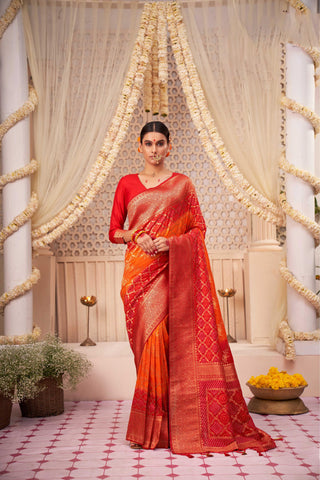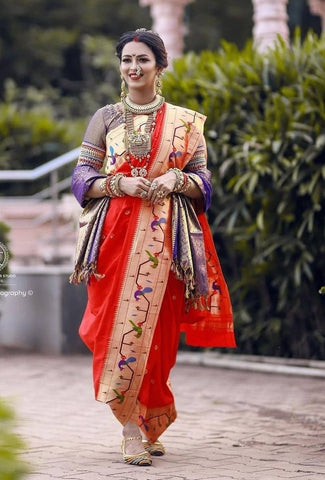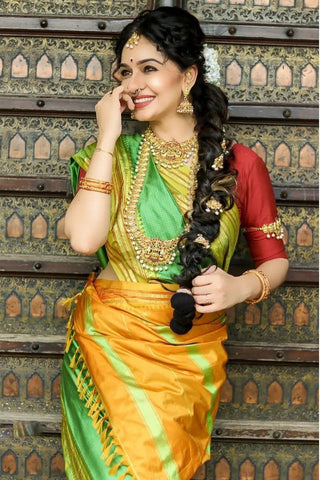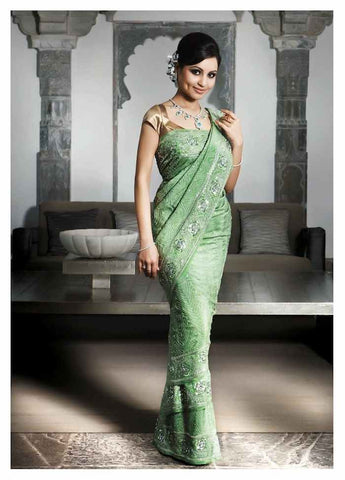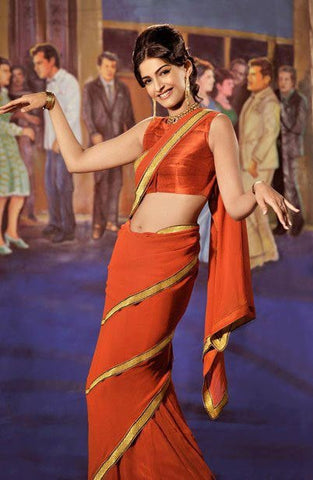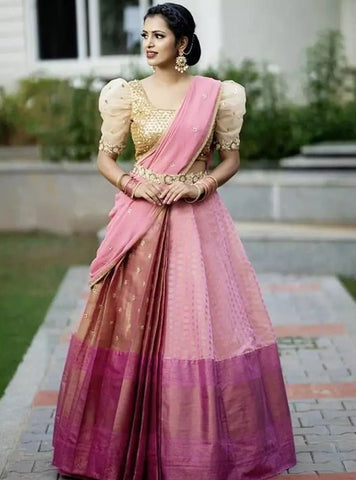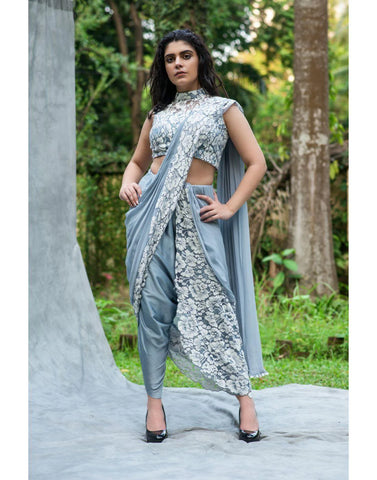What is the difference between net saree outfits and silk sarees?
Net sarees are lightweight and sheer, often embellished with embroidery, sequins, or lace, providing a delicate and modern look. Silk sarees, such as Banarasi, Pochampally or Kancheepuram,Muga Silk are known for their rich texture, durability, and intricate designs, offering a traditional and luxurious appearance.
How to Drape a Saree ?
Draping a saree is an art, with various trendy styles to explore. This 6-meter garment, worn with a blouse and petticoat, offers versatile looks. Wrap around the waist, create pleats, tuck in, and drape over the shoulder. Online tutorials provide helpful demonstrations for mastering this elegant attire. Whether opting for traditional elegance or contemporary flair, mastering the saree drape adds a touch of sophistication to any occasion.
What is Banarasi Saree ?
The Banarasi saree is a masterpiece of handloom craftsmanship, adorned with intricate golden or zari work. It can take anywhere from 2 days to 60 days to create a single Banarasi masterpiece. Weavers in Banaras intricately weave dreams into each thread, contrasting the transient nature of life that draws many to the city. Embellished with flowers in golden or copper threads on pure silk, the Banarasi saree sets the gold standard in handloom weaves, a timeless essential for every wardrobe.
How to find pure handloom Banarasi saree Online?
Finding pure handloom Banarasi sarees requires attention to detail and authenticity. Look for reputable sellers or brands known for their commitment to traditional craftsmanship. Authentic Banarasi sarees are handwoven with intricate designs using silk or fine quality yarns. Check for hallmarks like the "GI tag" (Geographical Indication) or " Silk Mark Certified tag" handloom certification to ensure genuineness. Examine the saree closely for fine weaving, distinct motifs, and high-quality finish. Additionally, buying directly from weavers' cooperatives or trusted online platforms specializing in handloom textiles can enhance the chances of acquiring a genuine Banarasi masterpiece.
What are the Patterns available over Banarasi Saree?
Banarasi sarees boast a rich variety of patterns, each reflecting intricate craftsmanship and timeless elegance. Common patterns include floral motifs like butidar (small flowers), jaal (net-like patterns), bel (creeping vines), and jhummar (paisley). Additionally, geometric designs such as checks, stripes, and diagonal patterns are popular choices. Traditional motifs like peacock, elephant, and mango are also prevalent, adding cultural significance to the saree. With Banarasi sarees, one can explore a myriad of patterns, each telling a unique story of artistry and tradition.
What is Kanjeevaram?
Kanjeevaram, also known as Kanchipuram, is a type of silk saree originating from the city of Kanchipuram in Tamil Nadu, India. Renowned for its exquisite craftsmanship and luxurious texture, the Kanjeevaram saree is traditionally handwoven using pure mulberry silk threads. These sarees are characterized by their vibrant colors, intricate zari work (metallic thread), and elaborate motifs inspired by temples, nature, and traditional designs. Kanjeevaram sarees are highly priced for their durability, rich cultural heritage, and timeless elegance, making them a choice for special occasions and weddings.
What are the Patterns available over Kanjeevaram Saree?
Kanjeevaram sarees showcase a wide range of intricate patterns, each adding to their allure and beauty. Some common patterns found on Kanjeevaram sarees include:
Temple motifs: Inspired by architectural designs of South Indian temples, these motifs often feature intricate depictions of temple pillars, motifs, and deity figures.
Floral patterns: Flowers like lotus, jasmine, and peacock motifs are commonly woven into Kanjeevaram sarees, adding a touch of natural elegance.
Checks and stripes: Traditional checks and stripes in contrasting colors are popular patterns seen on Kanjeevaram sarees, adding a classic yet contemporary appeal.
Animal motifs: Elephants, parrots, and other animal motifs are intricately woven into Kanjeevaram sarees, symbolizing prosperity, fertility, and grace.
Paisley designs: Paisley motifs, also known as mango motifs, are a hallmark of Kanjeevaram sarees, symbolizing fertility, abundance, and auspiciousness.
These patterns, combined with rich colors and fine zari work, create exquisite Kanjeevaram sarees that are treasured for their craftsmanship and elegance.
What are Assam Silk Sarees?
Assam Silk Sarees, also known as Assam Muga Silk Sarees, are traditional sarees indigenous to the northeastern state of Assam, India. These sarees are crafted from Muga silk, which is produced by the Antheraea assamensis silkworms native to Assam. Muga silk is renowned for its durability, natural golden sheen, and luxurious texture, making it highly prized in the world of textiles.
Assam Silk Sarees are characterized by their rich golden hue, which is unique to Muga silk. They often feature intricate motifs inspired by Assamese culture and nature, such as traditional Assamese motifs, flora, fauna, and geometric patterns. The sarees are woven on traditional handlooms by skilled artisans, with each piece reflecting the cultural heritage and craftsmanship of Assam.
These sarees are typically worn on special occasions such as weddings, festivals, and religious ceremonies. They are treasured heirlooms passed down through generations and are considered a symbol of prestige and tradition in Assamese culture. Assam Silk Sarees not only showcase the artistic skills of the weavers but also represent the rich cultural heritage of Assam.
Which Indian cities are famous for sarees?
Many cities in India are famous for their sarees. Some of them are Varanasi, Pochampally, Dharmavaram, Kolkata, Mysore, Kanchipuram, Managalagiri, Chanderi, Bishnupur, Kota, Maheshwar, Karaikudi and Sambalpur.
What are the different sarees available on Mohi?
Mohi has sarees of all types for all occasions. From Kanchipuram silk sarees, Banarasi Sarees, Handloom Sarees, Muga Silk, Assam Silk Sarees, Designer Sarees, Georgette Sarees, Pure Silk Sarees, Mysore Silk Sarees, Cotton Sarees, Organza Sarees, Kerala Sarees, Bandhani Sarees, Bengali Sarees, Jimmy Choo Sarees to Paithani sarees and many more, you can find everything on our website.
Which silk is the softest in India?
Mulberry silk is the softest silk in India. It is often used to create high-quality pure silk sarees, such as the Mysore silk saree and the Kanchipuram silk saree.
Which type of saree is in trend?
The trend in sarees continually evolves with the seasons, time, and occasions. Currently, some of the popular saree styles include handloom cotton sarees, Banarasi silk sarees with minimal Zari work, designer sarees, pastel-colored chiffon sarees with delicate embroidery, and sarees featuring contemporary prints like geometric and abstract designs.
Which saree color is most attractive?
Bright colors can make you feel confident and beautiful. Vibrant hues like red, blue, pink, and gold are particularly attractive and popular for their eye-catching appeal, mainly suits for weddings. Softer shades such as pastel pink, peach, or lavender also offer a delicate and elegant option for sangeet and occasions, catering to a variety of personal preferences.
Which saree makes you look slim?
Sarees made from chiffon, georgette, or crepe fabrics are great for achieving a slimmer look. Patterns like pinstripes or vertical lines further enhance this effect. Additionally, opting for dark colors such as black, navy blue, deep maroon, or dark green can also contribute to a more slender appearance.
What is the difference between Net Sarees and Silk Sarees?
Net sarees are lightweight and sheer, often embellished with embroidery, sequins, or lace, providing a delicate and modern look. Silk sarees, such as Banarasi, Pochampally or Kancheepuram, Muga Silk are known for their rich texture, durability, and intricate designs, offering a traditional and luxurious appearance.
What are the things to consider while shopping for the right saree for a mother of a bride?
When shopping for the right saree for the mother of the bride, consider the fabric for comfort and elegance, such as silk or chiffon. Choose traditional and sophisticated designs like Banarasi or Kancheepuram. Opt for rich colors that complement the wedding theme and ensure the saree has intricate detailing for a distinguished look.
What should be the ideal length of a saree?
The ideal length of a saree is typically between 5.5 to 6.5 meters. This length provides enough fabric to drape elegantly while accommodating various draping styles and body types.
Is it suitable to wear a saree to a party?
you can choose a saree with more intricate and glamorous designs. Consider sarees made from materials like silk, georgette, chiffon, or velvet, as they tend to have a more luxurious and party-appropriate look.
Which fabric is perfect for plus size?
Fabrics like chiffon and georgette are perfect for plus-size individuals due to their lightweight and flowy nature, providing comfort and flattering drapes. These fabrics offer a graceful silhouette while minimizing bulkiness. Additionally, stretchable materials like lycra blends can also be suitable for people who wear plus-size sarees, ensuring flexibility and ease of movement.
Which type of saree is most attractive?
The most attractive saree often depends on personal preferences , but Banarasi Silk sarees are highly esteemed for their intricate Zari work and luxurious feel. Kancheepuram Silk sarees are prized for their vibrant colors and traditional designs, while chiffon sarees are favored for their lightweight, elegant drape.
What do South Indian brides wear?
South Indian brides often choose traditional silk sarees like Kancheepuram or Kanjeevaram for their weddings. These sarees are known for their rich texture, vibrant colors, and intricate gold Zari work, symbolizing auspiciousness and cultural heritage. They exude timeless elegance and are a popular choice for South Indian bridal attire.
What is the significance of red color in bridal sarees?
Red symbolizes love, prosperity, fertility, and marital bliss in many cultures. For Indian women, red holds additional significance as it is considered auspicious, believed to ward off evil, and is traditionally worn to enhance the bride’s beauty on her special day.
How to choose the right bridal saree for my wedding?
Consider several important factors when choosing your bridal saree, including:
- The type of bridal saree that suits your style and preference
- The theme of your wedding for a cohesive look
- Colors and designs that complement your skin tone
- The fabric, ensuring comfort throughout your special day
Are there budget-friendly options for bridal sarees?
At Mohi, we bring you a selection of brands offering budget-friendly bridal sarees. Discover everything from leheriya to paithani, all at the best prices.
What are the Latest wedding saree trends?
The latest trend in wedding sarees is the Wedding Organza Saree. Loved by brides today, these elegant sarees feature a sheer organza fabric that’s lightweight yet luxurious, offering a stunning silk-like shine. This radiant finish adds a touch of grandeur, making them a top choice for the modern bride.
Which color is best to wear at a wedding?
Red sarees are an ideal choice for weddings, as the color red holds deep cultural significance across India, symbolizing auspiciousness and prosperity. Brides are often drawn to this vibrant hue, which beautifully complements the radiant gleam of gold jewelry, creating a stunning and timeless look.
Where can I find the best wedding sarees online?
Mohi is the ultimate destination to buy wedding sarees online, offering an exquisite collection tailored for your special day. Explore an incredible selection of wedding sarees on Mohi, where you’ll find stunning designs at the best prices for your big day.
Which type of saree is best for the wedding?
For weddings, sarees that drape gracefully, offering comfort, style, and a touch of tradition are ideal. Luxurious silks like Kanjivaram and Banarasi bring elegance and heritage to the occasion, especially when adorned with intricate designs and paired with statement jewelry. Other options include fine georgette, crepe, and chiffon sarees enhanced with embellishments and delicate zari work. Ultimately, the perfect wedding saree reflects personal style, cultural richness, and the occasion’s significance. The Mohi online store offers a curated selection for every preference.
What is the significance of red sarees, and why do they remain a timeless choice in Indian fashion?
Red sarees symbolize love, joy, and fertility, making them a choice for auspicious occasions like weddings, festivals, and celebrations. Saree red color also radiates power and confidence, making it a favorite among bold and dynamic Indian women.
Are red sarees suitable for both traditional occasions and celebratory events like weddings and festivals?
Yes, red sarees are perfect for both traditional and celebratory occasions, including weddings and festivals. As a vibrant and festive color, saree in red color is available in various shades such as maroon, crimson, cherry red, and scarlet, making it versatile for events like Garba nights, Diwali, Durga Puja, weddings, and even cocktail parties.
Bestseller:
Half Saree | Organza Sarees | Silk Saree | Bandhani Sarees | Bandhgala | Punjabi Suit | Kanchipuram Sarees | Bollywood Saree | Banarasi Sarees | Kerala Saree | Black Saree | Chiffon Saree | Patola Saree | Indian Kurti | Georgette Saree | Pink Lehenga | Wedding Saree | Mysore Silk Sarees | White Saree | Jamdani Saree | Gold Saree | Handloom Sarees | Pure Indian Silk Sarees | Assam Silk Sarees | Mekhela Chador | Paithani Sarees | Indian Sarees | Cotton Sarees | Gadwal Sarees | Pre draped Sarees | Organza Saree
Top 7 Places to Buy Indian Sarees in Malaysia
Indian Sarees Online in Kuala Lumpur, Malaysia
Indian and Pakistani Dresses Online in Kuala Lumpur, Malaysia
Sarees Online in Malaysia
Latest Indian Sarees in London, UK
Buy Indian Lehenga for Engagement in Devon Avenue, Chicago, IL
Latest Designer Sarees Online in UK
Designer Sarees
Buy Designer Sarees Online at Mohi Fashion
Designer Sarees for Women Online
Indian Sarees Online in Singapore
South Indian Saree Look for a Wedding in 2025
Saree online in New Jersey
